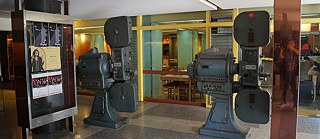Traces of Germany in Lebanon
Memories of the “Most Famous Promenade in the Middle East” – Bauer Film Projectors in Hamra

In the year 2002, the Saroulla closed its doors for business once and for all. It had been one of the most popular cinemas in Beirut in the 1960s, but the Lebanese Civil War (1975-1990) and the emergence of huge cinema complexes in its aftermath took a heavy toll on the small cinema. Fewer and fewer guests came. There was no money left for necessary repairs, and so, in the end, the cinema had to shut down. For three years the cinema stood empty until its successor, the "Metro al-Medina" variety theatre and cinema moved in.
“No one had looked after the building in the meantime. Everything was covered in dust and cobwebs”, Mohammed, the technical director of the Metro al-Medina, reminisced. After surveying the run-down auditorium upon his first visit, he went hunting for historical remnants in the basement. “The Saroulla was such a venerable old cinema that I was sure I’d find something exciting in the storeroom.” He was not disappointed. In the farthest corner of the storeroom, between old admission tickets and French and Egyptian film posters, he found four two-metre-sized film projectors manufactured by Bauer. Made in Germany, in Untertürkheim, to be precise – memories of a past, glorious age.
Before the Lebanese Civil War, Hamra Street was considered the most popular boulevard in all the Middle East and the intellectual heart of Beirut. Artists and intellectuals of all political stripes from all Arabic countries were drawn to Hamra, where they populated the cafes and nightclubs. While Cairo was the undisputed capital of Arabic film production, Beirut was the cinema capital of the Arabic world: in 1960, the average Lebanese went to the cinema 22.5 times – only Hong Kong had a higher attendance rate that year according to UNESCO. There were 14 cinemas on Hamra Street alone, including the infamous Eldorado, the Picadilly and the Versailles. The Saroulla, which was named after the wife of an American film producer, opened its doors in 1961. Lebanese cinemas were famous for their wide selection of films from Egypt, Hollywood and Europe, and for the high quality of their film screenings. When Mohammed found the German film projectors in 2005, many of which still used carbon arc lamps, he discovered that about half of them were still fully functional.
The Civil War split Beirut into a Muslim part in the west and a Christian part in the east. As a consequence, attendance rates dropped for the cinemas in the Hamra area in West Beirut, while private television sets grew in popularity. Militias occupied some of the cinemas and used their spacious basements as munitions dumps. Today, many of the cinemas in Hamra have vanished. Starbucks, H&M and Nike stores have taken their place. Faceless cinema complexes in huge malls have come to replace the old cinemas in Hamra. Although many of the German projectors Mohammed found in the basement of the Saroulla were still in working order, he still had no use for them. There is no museum in Lebanon dedicated to Beirut’s ‘Golden Age’. But since Mohammed didn’t want to just throw away these memorabilia of the old Beirut or leave them to gather dust in the basement, he decided to set up the projectors in the theatre’s foyer. Here, they draw curious gazes and serve to remind people of the ‘Golden Age’ of cinema culture in Beirut.